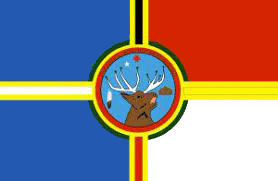Land Acknowledgement
This land always was, and always will be, Indigenous land.
Tāp Pīlam Coahuiltecan Nation

Image Source: The Tāp Pīlam Coahuiltecan Nation Flag via https://tappilam.org/
The Tāp Pīlam Coahuiltecan Nation, and The American Indians in Texas at the Spanish Colonial Missions, live on the unceded lands their ancestors lived on for centuries.
The Coahuiltecan people of 60+ nomadic bands, including the Payaya and Pajalat, reside on the lands of what is now called Northern Mexico and South Texas. And have since 12,000-8,000 B.P. Most recorded history accounts for only the last 300 years, or ~2%, of the land’s and peoples’ history. (1, 2, 7, 8)
Despite the Spaniard invasion, stolen lands, subjugation under the encomienda system, missionization, cultural genocide, and assimilation, the Coahuiltecan Mission Indians, later recognized as part of the Tāp Pīlam Coahuiltecan Nation, are not extinct. The Tāp Pīlam Coahuiltecan Nation is actively reclaiming their indigenous identity, language, histories, and excavated ancestral remains. (1, 2)
TheTāp Pīlam Coahuiltecan Nation currently advocates that Texas Missions history include histories of Indigenous peoples, communities of color, and enslaved peoples. (1,3)
Recent renovation plans for the Mission San Antonio de Valero, now called The Alamo, sparked debates on how to present historical fact. (3)
Currently, the history presented at the site focuses on a single 1836 battle while excluding thousands of years of Indigenous history and culture in the area. The site’s ties to racism and slavery are also ignored. (3)
Additionally, the Mission San Antonio de Valero is a sacred burial ground. Over a thousand Coahuiltecan Mission Indians are buried there. Each year, two million tourists tread over this cemetery. Previous requests to designate the burial ground as a historic Texas cemetery have been denied. (4, 6)
Since 1994, the Tāp Pīlam Coahuiltecan Nation has recovered their ancestral remains from universities and museums around the country.
The Tāp Pīlam Coahuiltecan Nation wants to ensure that the “Lineal Descendants of the people buried at the Alamo be consulted with and new Human Remains protocols be developed with their input”. The Tap Pilam Coahuiltecan Nation also wants representation on the Alamo Mission Archaeology Advisory Committee.
The Petition for representation is ongoing. (4, 6)
The American Indians in Texas at the Spanish Colonial Missions is a nonprofit organization established by the Tap Pilam Coahuiltecan Nation. AIT-SCM serves to preserve, protect, and celebrate their culture and traditions with events like the Annual Mission Heritage Dinner, art festivals, and the Coahuiltecan Language Program.
A mini-Online Yanaguana Heritage Tour, given by Lineal Descendants, tells the Indigenous history of the land as an introduction/sample of their in-person tour. (5)
The AIT-SCM also provides community support through programs like Healing the Wounded Spirit, The Fatherhood Campaign, and Warrior Roots training, as well as services for mental health counseling, youth services & mentorship, maternity care, and census & voter registration outreach. (5)
How i Healthy acknowledges and respects the Indigenous protocol of Land Acknowledgment.
How i Healthy acknowledges and respects that our office impedes on unceded Tāp Pīlam Coahuiltecan Nation territory and ancestral lands.
Learn & Get Involved
- The Petition for representation on the Alamo Mission Archaeology Advisory Committee
- The Importance of Land Acknowledgement, by North Sound Accountable Community of Health and Children of The Setting Sun Productions
- The Honor Native Land Guide, sponsored by the U.S. Department of Arts and Culture
- Changing the Narrative About Native Americans: A Guide for Allies, by Reclaiming Native Truth
- The Indigenous Peoples’ History of the United States, by Roxanne Dunbar-Ortiz
- Nation to Nation Treaties Between the United States and American Indian Nations, by Suzan Shown Harjo
- This Place: 150 Years Retold, a graphic novel anthology of First Nations history in Canada.
- Indigenous Continent: The Epic Contest for North America, by Pekka Hämäläinen
- “Home.” Tap Pilam Coahuiltecan Nation, tappilam.org/.
- Chavana, Adrian, “3. “Reclaiming Tribal Identity in the Land of the Spirit Waters”” (2019). NACCS Annual Conference Proceedings. 13. https://scholarworks.sjsu.edu/naccs/2019/Proceedings/13/
- Webner, Richard. “Alamo Renovation Gets Stuck over Arguments about Slavery.” The Washington Post, WP Company, 9 May 2021, www.washingtonpost.com/national/alamo-renovation-slavery/2021/05/07/ec8fe402-ae83-11eb-b476-c3b287e52a01_story.html.
- “Demand a 3rd Party Conduct a Comprehensive In-Depth Archival Study of The Alamo.” org, www.change.org/p/city-of-san-antonio-demand-that-a-3rd-party-conduct-a-comprehensive-in-depth-archival-study-of-the-alamo.
- American Indians in Texas at the Spanish Colonial Missions, aitscm.org/.
- Martinez, Norma. “’We’re Still Here’ – 10,000 Years Of Native American History Re-Emerges.” TPR, 14 Mar. 2019, www.tpr.org/san-antonio/2019-03-14/were-still-here-10-000-years-of-native-american-history-re-emerges.
- Ayala, Elaine. The Native American Story in S.A. Is 15,000 Years Old, and Counting. San Antonio Express-News, 24 Mar. 2018, www.expressnews.com/sa300/article/The-Native-American-story-in-S-A-is-15-000-years-12777871.php.
- “Story Map Series.” 300th Years Anniversary Celebration of Bejar, Bexar County, Texas, bexar.maps.arcgis.com/apps/MapSeries/index.html?appid=483e4d0ce14d452b85bb1a6680218181.


